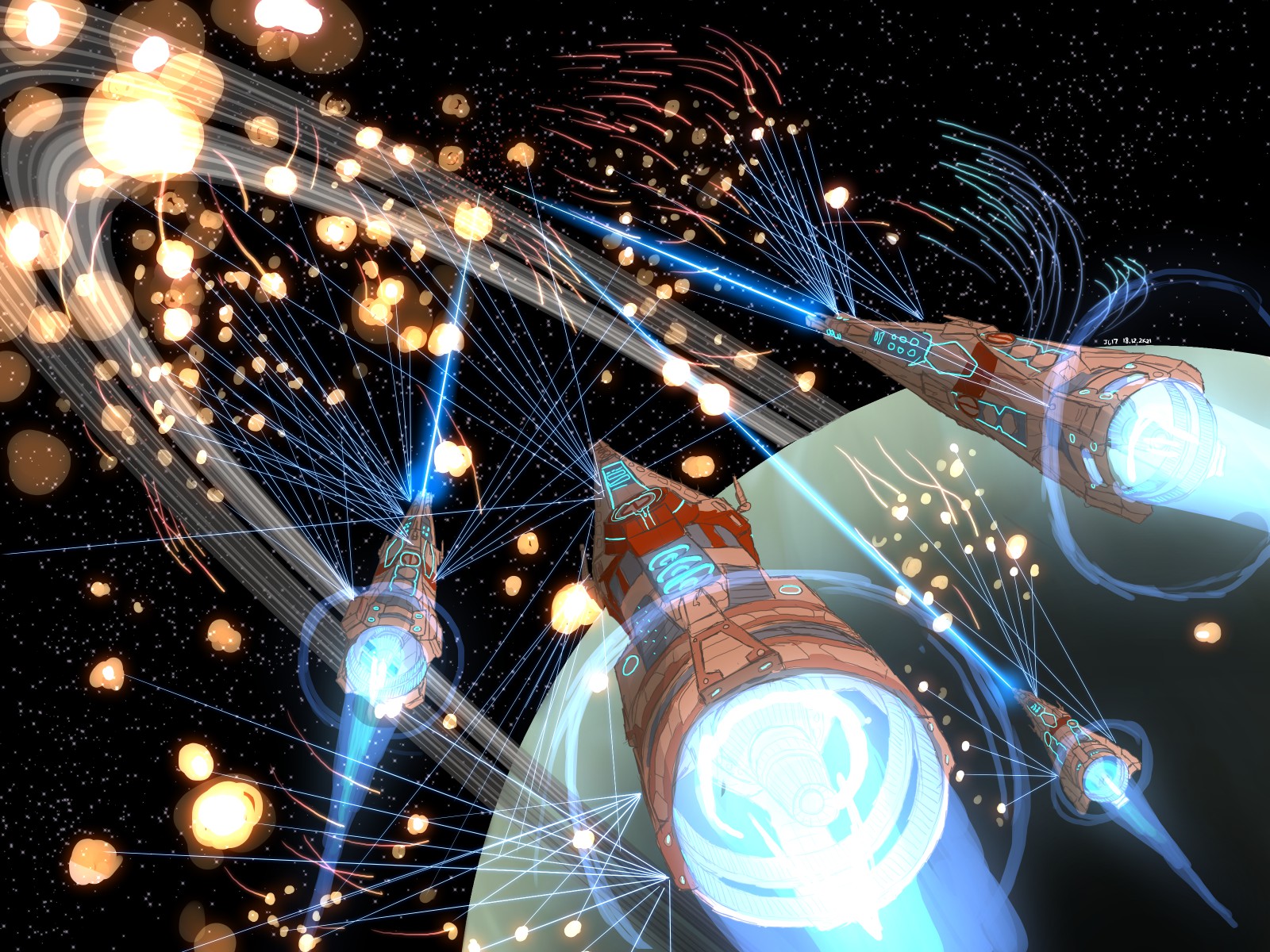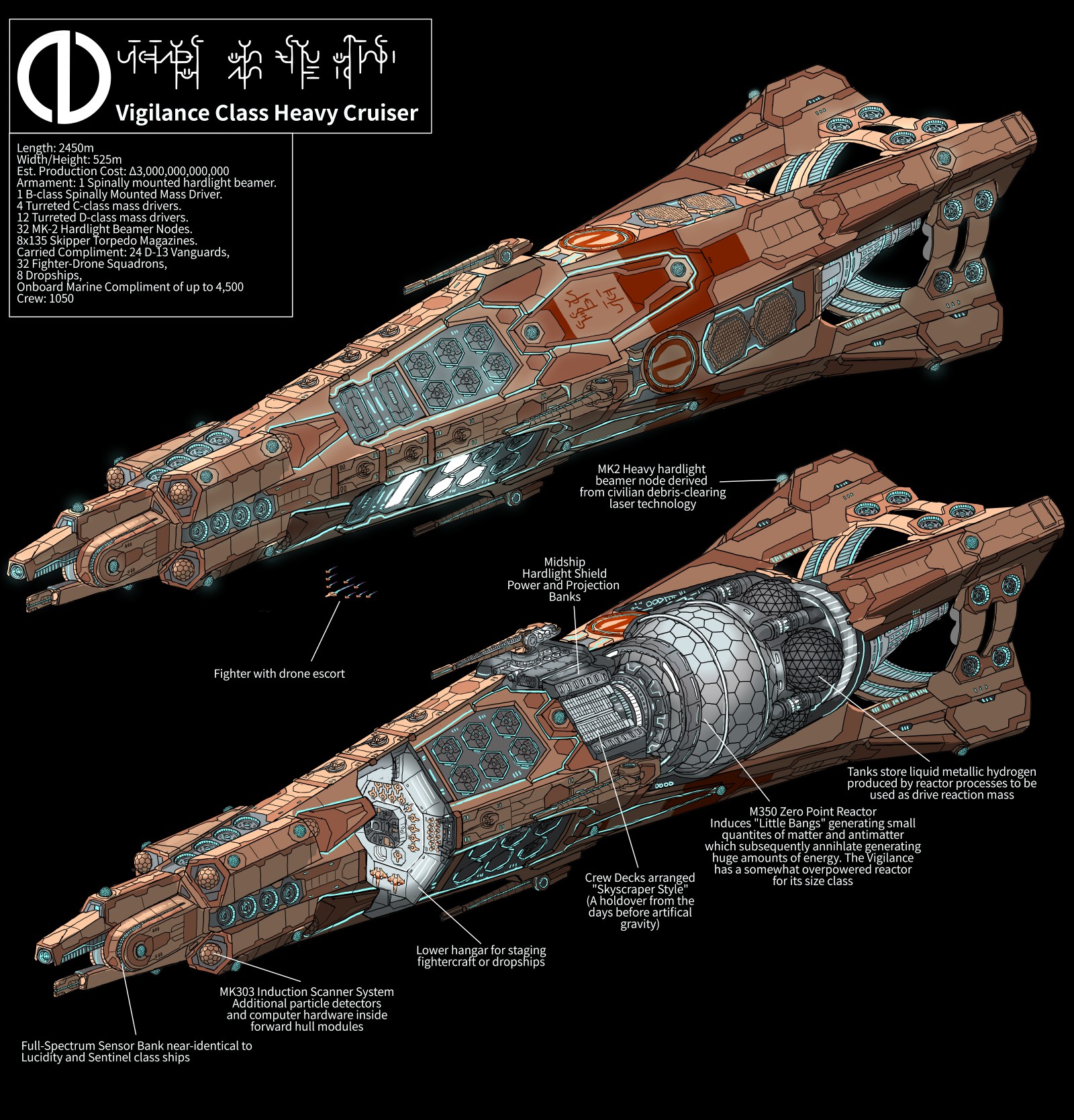Vigilance Class Heavy Cruiser
"Can't fight what you can't see..."
The Vigilance-Class Heavy Cruiser was a voidcraft in service to the gaussian astral fleet, though the jury is out on whether it is the most popular vessel within the greater Gedau cluster. "Vigilance Class Cruiser" is not its true name. In Kimbeau it is referred to what more approximately translates as "The Never-Sleeping Huntress Secondary Combat Ship" It is most certainly one of the most iconic vessels within its corner of the universe. Being a powerful jack-of-all trades, it has seen action in the last century doing everything from hunting petty pirates and lurking courdeel to participating in the first intergalactic wars.
Doctrine and Design
The Vigilance is the cornerstone of dominion ship design, and the culmination of their design tendencies. Though one could argue the most recognizable warcraft in the gedau supercluster was perhaps the Saigdinian Astitlae-class frigate or the UNE Thrasher-class destroyer. Ships who occupied similar mainstay roles in their respective navies. The Astitlae emphasized being easy to mass produce, while the Thrasher emphasized an almost impenetrable defense. The Vigilance emphasized versatility and sensor capacity. The Vigilance was intended to carry out two primary duties. One being independent patrol or escort; with the ship being versatile enough and powerful enough to fend off pirates or small courdeel scout forces all on its own. The second being as an anti-stealth destroyer and escort vessel for large battleships and dreadnoughts. Powerful enough to participate in grand-scale engagements without putting itself and its crew at undue risk while being able to protect supercapital warcraft from being outmaneuvered, overwhelmed or surprised.Production
Vigilance Class Cruisers are typically assembled in moon-sized shipyards such as Tetrohmuro in the Tausangrool system or Tojunmuro in the Gantariak System. A large trench or carousel will be cut into the crust of a small moon-sized body and covered over, then pressurized with a standard atmosphere. This creates a breathable low-gravity environment for production to take place. Workers can preform construction without space suits, instead wearing regular clothes and wing suits that they can fly by flapping their arms. In low gravity this allows them to fly on the vertical structure of the ship to where they need to work. Individual modular components will be produced on production lines and then slotted together. Relatively small ducted fan craft can be used to lift heavy components in the low gravity. The ships are built on their tail end, and when completed can be launched via an airlock.Power Generation
The Vigilance utilizes a single M-350 Singularity Reactor, somewhat oversized for a cruiser class vessel. This gives the ship something of an all-or-nothing design as though there are subsidiary fusion reactors, they do not provide ample power for running weapons, shields or superluminal travel. Though this reactor is very powerful and reliable and the high power generation makes the craft a vicious opponent as energy can quickly and relaibly be generated and diverted to weapons and shields for sustained engagements.
Propulsion
Sublight Propulsion
The Viglance possesses a single liquid protium ringjet. This fusion-based engine in some sense works like a traditional toroidal fusion reactor with some of the walls removed. The central column stabilizes the fusion while the outer rings contain magnetic arrays to manipulate it into usable thrust. This squeezes the hydrogen, recreating conditions typically only found in dying stars. The products of the fusion (a jet of radioactive iron) are accelerated out the rear of the spacecraft at relativistic speeds, propelling the craft forward. 32 Reaction thrusters, essentially more compact versions of the same system could translate the vessel in 3D space to preform evasive maneuvers when fighting at ranges of a few light seconds.Superluminal Propulsion
The Vigilance makes use of a standard subspace drive, and is able to travel at around 1000 light years per hour of absolute time.Weapons & Armament
Hardlight Projector
The Viglance features a light hardlight projector as its primary weapon. This projects a holographic laser beam possessing some properties of a kinetic weapon as well as some properties of a traditional laser. This weapon can fire at various power settings and use stored reserves of energy to fire quick but extremely intense bursts or use the sustained output of the reactor to fire continuous beams. It also possesses a limited capacity to gimball several degrees of the ship's front axis to allow for precise aiming.Mass Drivers
The Vigilance has a spinally mounted Class-B mass driver, able to accelerate a 12.5 ton projectile to 0.4c. This is intended primarily for planetary bombardment and attacking stationary targets such as battlestations due to its limited capacity to aim. Four Class-C mass drivers are installed on the main axes. Linked to reinforced and computer-stabilized turret mounts they are able to accelerate a more modest 5 ton projectile to 0.35C. These mass drivers can fire viciously fast, with modern iterations able to cycle in around a second. Twelve Class-D mass drivers are installed along the forward axis. These function as kinetic point defense, firing one-ton projectiles at 0.25c. Often loaded solely with flechette rounds to intercept small spacecraft or missiles.Missile Pods
The Vigilance features 8 standard detachable hexagonal missile pods. Typically these would carry two reaper missiles per launch tube. 19 tubes would be installed in a single missile cell (originally designed for a single larger skipper missile). This meant, fully loaded the ship could carry 41,010 anti ship missiles. Such vast quantities would be needed to attack hard targets and saturate point defenses. The missile magazines were detachable with small plasma reaction thrusters, such that they could be easily exchanged with a logistics ship or base. Or be jettisoned to reduce mass in the event of an emergency.Vanquisher Point Defense System
32 Vanquisher Point Defense System nodes. Dome-like point defense installations capable of rapidly firing fans of hard light beams, these were ubiquitous across the dominion navy.Armor and defense
Armor
The armor of the vigilance was fairly modest. Though it could survive relativistic flechettes, low-yield nuclear shaped charges or small energy weapons, the ship was not particularly well armored. Relying on speed, shielding and a robust active defense to ensure its survivability. The armor was made up of a fairly traditional composite with an outer tazutun layer (giving the ship its tan coloration) as well as layers of metal foam spaced apart to absorb heat and kinetic energy. The innermost layer possessing a comparatively thick arsium strikeplate. Additional heavier armor was installed around the reactor and central bridge in the event of critical damage, the ship's proverbial heart and brain could continue functioning.Hardlight Shield
The vigilance featured a powerful standard hardlight shield to make up for its relatively weak hull structure. With state-of-the-art sensors and a powerful reactor it was possible to generate hardlight plates efficiently and rapidly. The shield could still be overwhelmed by continuous fire or by being attacked from multiple directions. Being a strictly reactive system, all hardlight shields were vulnerable to any weapon they could not detect.Communication Tools & Systems
Encrypted Tightbeam
A traditional communications system which would use a tightbeam Radio-laser to beam communications to a target, increasing signal power, reducing the likelihood of interception.Subspace Beamer
Another method of radio communication which called for beaming radio waves through subspace and setting them to emerge at a specified point. This could allow for superluminal communications over moderate distances, sometimes to local star systems.Quantum Thread Switchboard
An internal piece of communications equipment that allowed for instantaneous superluminal communications by installing a quantum bridge chip into the ships communications board. This contained a quantum-scale "entangled" wormhole through which information could be sent. This was limited in that only one other chip could send and receive signals, and required the physical exchange of the chips. Bandwidth was also limited primarily to text or audio based messages. Holographic video feeds or dense data dumps could take impractically long periods to transmit. But was highly secure and impossible to tap into without breaking.Sensors
FEMS
High resolution high framrate passive FEMS sensor systems including a pair of Lucidity-type forward sensor bunkers This sensor node produces a 150 Petapixel (150 quadrillion pixel) image utilizing advanced self-healing receptor chips and hardened with polarized lenses. The image is rendered with a “framerate” of around 5,000 FPS.CMSS
Cuboidal Magnetometer Sensor System. This system contained eight magnetic moment detectors arranged in a cube. The detectors could determine the strength and direction of a magnetic field, but required the ship's engine to be turned off as its magnetic field could interfere with the detector.GMTSS
Gravitational Microctractor Sensor System. This sensor system would actively scan a region of space by shooting out tiny newtonian gravitational tractors. If these tractors interacted with an object that was not detected by other systems, they would exert a small pull on the detector and the targeted object. This data would be checked with visual data to search for cloaked spacecraft as a gravitational pull where there was otherwise no visible object indicated a cloaked object.Kasidon-VCC Holographic Radar System
A set of 4 1.20PW X-ray holographic radar systems. These scanners were equipped to project holograms shifted into the near-Xray spectrum. They would project grids holographic photons and scan for distortions or delays within the return signal. This observation could be used to detect optical cloaking fields.SIS MK303
An subspace induction scanner system. This system would scan a hyperspherical cross section of 11-dimensional hyperspace at superluminal speeds. By looking "down" from higher dimensions, objects which were otherwise perfectly cloaked could be detected. This could detect the signatures of objects hiding in higher dimensions of space. The SIS system could function while the internal teleportation denial system was online thanks to the nodes being partially outside the vessel, but not when any expansive form of interdiction or dampening was utilized.Additional & auxiliary systems
Spacetime Lattice Generators
The Vigilance features two Tau'norensaka Preon Hypercrystal folding spacetime lattice generators. Producing a lattice of quantum strings, these completely rigidify the normally malleable fabric of space time preventing teleportation or superluminal travel within range of the field. The weaker of the two was carefully shaped to the hull form of the ship and automatically activated when the ship exited subspace; deactivating a moment before entering subspace. The larger of the two could create a spherical field extending to a few light-seconds restricting superluminal travel and some forms of communications within that range.EWAR System
A powerful rainbow blinding system was integrated into the Vigilance designed to disrupt sensor systems with strobing and rapidly changing holographic light sources. This system contained quantum jammers which could disrupt quantum bridge communications without permanently breaking the quantum bridge system, and could project "radio hologram" decoys to fool long range targeting systems.Hangars & docked vessels
The Vigilance could carry 24 Vanguard or Seeker gunships in its hexagonal hangar bays. Its further compliment was highly variable but when configured for space warfare could include 32 fighters and their drone wings, as well as 12 Xashur Dropships.
Designation
VCC
Creation Date
1111DE
Owning Organization
Price
Δ3,000,000,000,000
Rarity
Common
Related Technologies
Beam
525 meters
Length
2475 meters
Height
525 meters
Weight
50,000,000 metric tons
Speed
35G (Tactical Acceleration) 70G (Deuterium-Tritium Booster) 1000LY/HR (Subspace)
Complement / Crew
150 Officers, 900 Enlisted, 28,000 Squires of various models
Cargo & Passenger Capacity
4500 Passengers, 1 years' provisions.




Comments